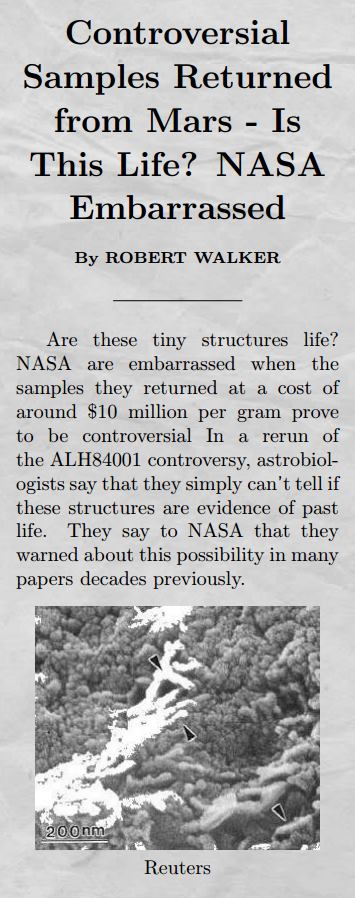
If Martian microbes are encased in the ice of the Red Planet, they may remain surprisingly well-preserved. Recent experiments indicate that protein fragments from bacteria could endure for more than 50 million years in pure ice, even with ongoing exposure to cosmic radiation. This significant timeframe exceeds scientists’ expectations, suggesting that future missions searching for life on Mars should likely focus on the ice rather than the rocks.
These insights originate from a collaboration between researchers at Penn State and NASA Goddard Space Flight Center, who effectively simulated Mars-like conditions in their laboratory. They froze E. coli bacteria in test tubes, subjected them to gamma radiation to mimic cosmic rays, and analyzed the remnants. The findings were remarkable: in pure water ice, over 10% of the amino acids, vital components of proteins, withstood what equates to 50 million years of cosmic radiation. In samples combined with Martian-like soil and minerals, however, amino acids deteriorated ten times faster.
“Fifty million years vastly surpasses the anticipated age for some current surface ice deposits on Mars, which often span less than two million years, suggesting that any organic life trapped within the ice could be preserved.”
This perspective comes from Penn State’s geosciences professor Christopher House, highlighting a crucial point. Most surface ice on Mars is geologically young, typically under a couple of million years old. If microbes or their remains became ensnared in that ice, perhaps hitching a ride on dust particles or lying dormant in the frozen ground, they would have ample time before radiation obliterated all evidence of their existence.
## Why Ice Offers Better Protection Than Soil
The protective mechanism may initially seem counterintuitive. One might assume that minerals would safeguard delicate organic molecules, but the contrary appears to hold true. When radiation interacts with ice blended with soil particles, it generates a thin layer of liquid water where ice contacts mineral surfaces. Even at minus 60 degrees Fahrenheit, the temperature utilized in the experiments, these ultra-thin water layers remain liquid because water molecules bond more aggressively to mineral surfaces than to the adjacent ice.
These liquid layers function like conduits for harmful particles. Radiation breaks water molecules down, forming hydroxyl radicals and other reactive entities that damage amino acids. In pure ice, such radicals become immobilized. They cannot circulate to inflict significant damage. Lead researcher Alexander Pavlov from NASA Goddard, who earned his doctorate at Penn State two decades earlier, noted that this finding took them by surprise.
“According to the 2022 study findings, it was believed that organic matter in ice or water alone would decompose even more swiftly than the 10% water mixture. Thus, it was unexpected to discover that organic materials embedded in pure water ice are degraded at a markedly slower pace than the samples including water and soil.”
## Where to Explore on Mars
The consequences extend to mission planning. NASA’s 2008 Phoenix lander already confirmed the presence of ice just beneath the Martian surface in its polar regions. There is actually a substantial amount of frozen water on the Red Planet, although most exists just beneath the dusty exterior. Accessing it requires robust excavation machinery, akin to Phoenix’s robotic arm but likely more powerful for deeper drilling efforts.
The research team also assessed how organic materials would endure on Europa, a moon of Jupiter, and Enceladus, a moon of Saturn, both of which possess even colder ice than Mars. The extreme temperatures there further slowed degradation rates, a positive outcome for NASA’s Europa Clipper mission, set to launch in 2024 and making its 1.8-billion-mile voyage to Jupiter in 2030.
For Mars, the conclusion seems clear: if you are in search of signs of life, whether recent or ancient, focus on the ice. The amino acids won’t endure indefinitely, cosmic radiation ensures that, but 50 million years allows biology a viable opportunity to leave traces behind. Future Mars missions seeking current life should prioritize ice-rich regions as prime sampling sites, avoiding clay deposits and rocky landscapes where organic molecules degrade significantly faster.
The study examined radiation exposure by freezing bacterial samples and moving them to a gamma radiation chamber at Penn State’s Radiation Science and Engineering Center, maintained at Mars-like temperatures. After exposing the samples to radiation equivalent to 20 million years of cosmic ray exposure, researchers sealed and transported them back to NASA Goddard for amino acid examination, then mathematically modeled an additional 30 million years.
Mars’ surface ice distribution continuously changes due to shifts in the planet’s axial tilt over millions of years. The most recent Martian ice age concluded between 2.1 and 0.4 million years ago, with ice sublimating from lower latitudes and redepositing at the poles. Any amino acids that settled in that ice during the last few million years, whether from meteorites, dust, or potential Martian organisms, would likely remain there, chemically intact and ready to share their story.
[Astrobiology: 10.1177/153110742513